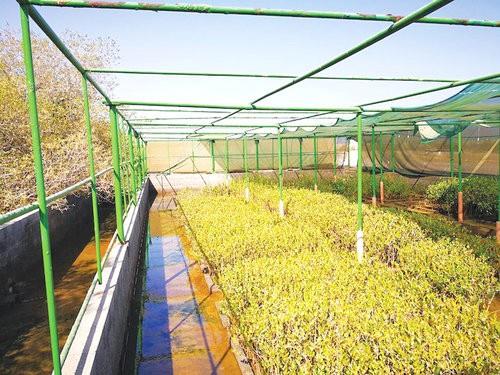
Mangrove restoration paying dividends in Oman: UN Environment Programme
Historical and archaeological evidence indicates that dense mangrove woodlands covered much of Oman's coastline and islands in ancient times, the agency stated.
'Now efforts to restore the natural mangrove habitat are beginning to bear fruit: Once again they are providing camel fodder, mangrove timber, cleaner air, more productive fishing grounds, resistance to salinity, and protection against tidal storms,' it said.Since 2000, Oman has been working with the Japanese International Cooperation Agency (JICA) to plant seedlings in seven of the country's 11 governorates. 'This is a pioneering activity that can inspire the development of a region-wide strategy for the management of marine and coastal ecosystems, and its future implementation,' said Kanako Hasegawa, a UN environment ecosystems expert.
The Regional Organization for the Protection of the Marine Environment (ROPME members are Iran, Iraq, Kuwait, Oman, Qatar, Saudi Arabia and the UAE), JICA and UN Environment are working together to support member states on the strategy.Molluscs, crabs and a variety of fish abound in the numerous Omani creeks, channels, and mudflats associated with this habitat. They shelter among the mangrove roots and feed on leaf detritus. The government has been protecting existing mangroves, and organising, coordinating and implementing the planting of seedlings, and conducting awareness campaigns across the country. Re-seeding mangroves in Oman is an uphill task – when the transplantation site is properly selected, 70 per cent to 80 per cent of the seedlings planted mature into trees. Seedlings take five years to grow into trees and start the natural germination process.
'Our priority is to conserve existing forests, and expand them by replanting seedlings,' said Aziza Saud al Adhubi, an environmental planner in the Marine Environment Conservation Department in the Ministry of Environment and Climate Affairs.The aim of the ambitious long-term project is to plant about 1mn mangrove seedlings. Roughly 700,000 seedlings have been planted so far. Local communities up and down the coast will benefit as they gradually get back the healthy ecosystems they had lost over the past decades, the agency said.
'Mangroves are breeding grounds for many fish species and other fauna, and also soak up carbon dioxide, thus contributing to mitigating the impact of greenhouse gas emissions. They protect the shore from coastal erosion. Mangrove boardwalks can also be a tourist attraction, bringing in additional income to locals. Over the years people have become more aware of the value and importance of mangrove ecosystems, and have increasingly participated in mangrove seedling plantation efforts,' said Aziza.

Legal Disclaimer:
MENAFN provides the
information “as is” without warranty of any kind. We do not accept
any responsibility or liability for the accuracy, content, images,
videos, licenses, completeness, legality, or reliability of the information
contained in this article. If you have any complaints or copyright
issues related to this article, kindly contact the provider above.


















Comments
No comment